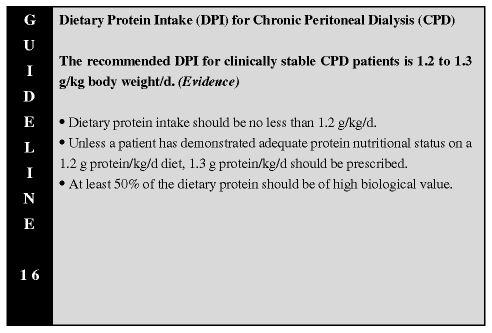
3. Management of Protein and Energy Intake

The fact that patients with ESRD treated with CPD often have PEM emphasizes the importance of maintaining an adequate intake of protein.29,30,33 Many of the causes of malnutrition in CPD patients are similar to those in MHD patients. However, protein losses into peritoneal dialysate are almost invariably higher than are protein losses into hemodialysate. Peritoneal protein losses average about 5 to 15 g/24 hours, and during episodes of peritonitis, dialysate protein may be considerably higher.144 Peritoneal amino acid losses average about 3 g/d,145 and some peptides are dialyzed. Anorexia due to glucose absorption from dialysate may also contribute to reduced dietary intake and malnutrition. These factors result in a requirement for dietary protein that is higher than in the normal population. Compounding these factors and predisposing to malnutrition is the finding that DPI is often rather low, less than 1.0 g/kg/d. As with MHD patients, malnutrition in peritoneal dialysis patients is associated with poor outcome.16,19,44,145,147
Several studies have examined nitrogen balances in CPD patients consuming various levels of dietary protein. These studies indicate that DPIs of 1.2 g/kg/d or greater are almost always associated with neutral or positive nitrogen balance.59,60,148 A number of studies show a relationship between DPI and such nutritional parameters as serum albumin, total body protein and nitrogen balance in patients undergoing CPD.59,60,148 Based on these considerations, it is recommended that a safe DPI that will maintain protein balance in almost all clinically stable CPD patients is at least 1.2 g protein/kg body weight/d. A DPI of 1.3 g/kg/d probably increases the likelihood that adequate protein nutrition will be maintained in almost all clinically stable individuals. At least 50% of the protein should be of high biological value. The nPNA for a 70-kg man ingesting 1.2 g and 1.3 g protein/kg body weight/d, based on the Bergstrom and Blumenkrantz data, is estimated to be 1.02 and 1.14 g protein/kg/d.149,150 It is recognized that some CPD patients will maintain good protein nutritional status with somewhat lower dietary protein intakes. The current guideline is recommended to provide assurance that almost all clinically stable CPD patients will have good protein nutrition.
Patients who do not have an adequate DPI should first receive dietary counseling and education. If DPI remains inadequate, oral supplements should be prescribed. If the oral supplements are not tolerated or effective and protein malnutrition is present, consideration should be given to use of tube feedings to increase protein intake. Amino acids may be added to dialysate to increase amino acid intake and to replace amino acid losses in dialysate.151,152